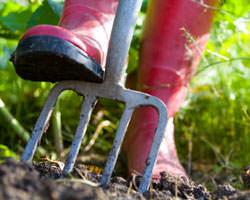
Courtesy USDA/ Peggy Greb
Canada thistle (pictured) is a perennial weed that troubles farmers throughout the U.S. University of Illinois studies show that Sudangrass can be used as a smother crop to control the weed. |
Farmers who don’t rely on or who want to minimize the use of chemical herbicides need creative solutions to win the battle against aggressive perennial weeds. In ongoing research at the University of Illinois on Canada thistle, Sudangrass is proving to be a worthy contender as a summer smother crop.
“Sudangrass gets very tall; it out-competes the thistle for light. The Sudangrass creates shade so photosynthesis cannot occur in the thistle,” said University of Illinois weed scientist John Masiunas. “In our test plots, primarily in the northern part of Illinois, we’ve seen 95 percent control, so farmers can plant a cash crop the following year in the patch that had been infected with Canada thistle.”
Planting time of Sudangrass is critical if used as a smother crop.
“It’s got to be seeded in the first couple of weeks in June. If you get much past the mid-to late June, the Sudangrass is not able to compete adequately, because the thistle grows rapidly in that time period,” Masiunas said.
A combination of mowing and tilling the Canada thistle before planting the Sudangrass is also recommended.
“Tilling and mowing the thistle interrupts its life cycle so that it can’t put energy back into the roots,” Masiunas said.
Mowing the Sudangrass is also important for several other reasons.
“You can mow to prevent seed heads from forming on the Sudangrass and reseeding itself, and mowing helps to control the amount of residue,” he said. “If you let the Sudangrass grow the entire season, you’ll have a plant 7 or 8 feet tall, with a lot of shoot tissue—a lot of biomass to deal with. So when you mow it, you just leave it as a surface mulch.”
Research on the use of Sudangrass as a smother crop, conducted by University of Illinois graduate student Abram Bicksler, originated from organic farmers’ questions about Canada thistle.
“Particularly for sustainable or organic farmers, Canada thistle was becoming very difficult to manage and was becoming the problem weed,” Masiunas said.
After Bicksler’s project was completed, Masiunas received funding from Sustainable Agriculture Research and Education for additional research with farmers around Illinois. For the past three years, research specialist Dan Anderson has been working with nine to 20 farmers each summer on environmentally friendly ways to control Canada thistle.
“The farmers I’ve been working with are primarily in the northern part of Illinois,” Anderson said.
Because of the weed’s adaptation, Canada thistle needs a longer day, so it’s not as much of a problem in southern Illinois, Georgia, Mississippi or Alabama.
“I’ve seen some horrible fields in northern Illinois, just full of thistle,” Anderson said. “The Sudangrass was planted on patches of ground where Canada thistle was prevalent, some larger patches and some smaller. That’s one of the advantages—you don’t have to devote the entire field to this.”
Masiunas stressed that the problem of Canada thistle is usually found in patches.
“What we’re aiming at is to eliminate a problem in patches that occur in a field. Our purpose is not to manage Canada thistle on 100 acres but in areas that might be 100 square feet,” he said. “The hope is that the farmer would catch the Canada thistle in a relatively small patch in an intensively managed farm. If they’re doing a lot of tillage, they’re not going to have as severe a case of Canada thistle. If they’re doing reduced tillage and staying on top of the weeds, they might have a small patch of Canada thistle, but it shouldn’t have taken over a whole field.”
Anderson said that some of the farms he has been working with also have a livestock component.
“The Sudangrass can be mowed and left as a smother crop, or it can be grazed,” he said.
Masiunas said that farmers might incorporate Sudangrass as an integrated pest management approach if they’re trying to diversify their management strategies.
“You’re generally not going to get 100 percent control with any type of herbicide that you can use against Canada thistle—95 to 98 percent control is about the best you’ll get with the best application of herbicides. And we’re getting a similar level of control with Sudangrass.”














